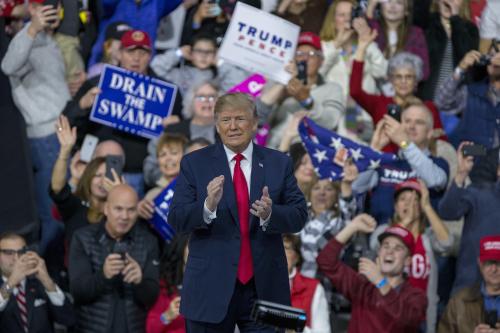A generation ago, in the aftermath of a stunning upheaval on the streets of Iran and the implosion of the formerly intimate relationship between Washington and Tehran, American policy makers and scholars engaged in an extraordinary debate about the nearly universal failure of the West to anticipate the 1979 revolution. The policy debacle was attributed to a host of factors, including constraints on U.S. intelligence gathering and the mutually intertwined personal and financial interests that evolved to bind the United States to the monarchy. But largely our momentous miscalculations in 1979 reflected the strength of our erroneous and unchallenged assumptions about Iran and its political dynamics.
Three decades later, Washington is confronted once again with evidence of how little we understand Iran. While there was intense attention to the June 12 presidential election and its potential impact on Iran’s internal balance of power and foreign policy, no serious analyst or scholar predicted the series of events that has transpired in the wake of that ballot. The primary developments in this crisis would have been dismissed by the array of Iran experts—myself included—as implausible or even inconceivable, particularly the blatant rigging of the presidential election; the defiance of the supreme leader’s authority by political actors who are part and parcel of the revolutionary state; and the coalescence of mass protests and the skeletal framework for a broad-based opposition to the Islamic Republic.
While Iran is not yet on the cusp of revolutionary change on the scale of 1979, the events of the past two weeks have offered a powerful reminder that Washington and the world routinely get Iran wrong. As in 1979, our misreading of Iran appears to be the product of a series of entrenched assumptions about the country, many of which have been controverted in the past two weeks. As the United States begins to chart a path forward for dealing with this crisis and an Islamic Republic which will be forever changed by the breaches that have occurred, it is worth examining where we went wrong. There are no doubt an array of additional misconceptions that have hampered our ability to anticipate events in Iran, but the following four points represent some of the lessons learned in recent days.
1. Khamenei as Balancer
Much of the literature about Iran has tended to portray Iran’s current supreme leader, Ayatollah Ali Khamenei, as a relative moderate whose primary interest lies in mediating between the ideological poles that separate the feuding factions within Tehran’s political elite. This perception may have reflected conjecture based on Khamenei’s acknowledged limitations in terms of both charisma and theological credentials. Whatever the genesis, the depiction of Khamenei as a closet pragmatist or systemic stabilizer bears no resemblance to the politician who has progressively amassed more authority under his own auspices, invariably aligned with Iran’s conservatives and offered his full-throated support to hard-line President Mahmoud Ahmadinejad.
2. Legitimacy and Representative Institutions
Another widespread assumption about the Islamic Republic that has been scuttled over the past two weeks concerns the centrality of Iran’s representative institutions and its popular legitimacy. Iranians have a century-old commitment to republicanism, powerful enough that the purveyors of theocracy were forced to incorporate an elected parliament and presidency into the Islamic Republic after they succeeded in ousting the shah. To observers, these representative institutions and the persistence of a limited role for popular sovereignty were integral to the Islamic Republic’s endurance. That may well be the case, but what the shameless manipulation of the election showed is that the relevant segment of its leadership does not share this view. They were fully prepared to jettison the already debilitated role for Iran’s representative institutions in order to eradicate what they perceived as a threat to the regime’s stability. Khamenei and Ahmadinejad have calculated that mass alienation from the regime is less dangerous to the perpetuation of their authority than mass participation in its politics.
3. Iranian Aversion to Unrest and Instability
The prevailing view of many observers for many years has been that as a result of revolutionary fatigue and political cynicism, Iranians are simply not willing to go to the barricades on behalf of any political movement. This was seen as the product of their historical disappointments, compounded instability associated with more recent experiences with regime change in the region. A corollary to this assumption was that none of the reformist politicians—most of whom were inherently cautious and all of whom were intricately interconnected with the structure of power that has evolved since 1979—would be willing to challenge the system, and Khamenei’s authority, and risk their status as khodi, or insiders. Both of these presumptions have been shattered in recent days and while the regime may succeed in its repression in the short-term, these events have clearly altered the political calculus for both the population and a narrow but important swath of the reform movement’s leadership.
4. The Economy as Iran’s Primary Vulnerability
Particularly over the past four years, the media as well as policy makers have routinely speculated on the prospect for economic grievances to spark turmoil that might threaten the Islamic Republic. The longstanding distortions that plagued the Iranian economy have been greatly exacerbated by Ahmadinejad’s spendthrift, interventionist policies and in recent years Iranians have had to contend with double-digit inflation and unemployment rates. Analysts often pointed to small-scale labor actions—as well as the popular reactions to a new program of gasoline rationing and other poorly-designed efforts to revamp the government’s vast subsidies—as the harbingers of mass unrest. They were repeatedly wrong on this count; Iranians grumbled and routinely vented their outrage over the economic conditions, but largely resigned themselves to making do. Instead, what drove the Iranian people into the streets in record numbers and established the nascent stirrings of a popular opposition to the creeping totalitarianism of the Islamic Republic was a purely political issue – the brazen abrogation of their limited democratic rights.



Commentary
Op-edMisreading Tehran
June 26, 2009